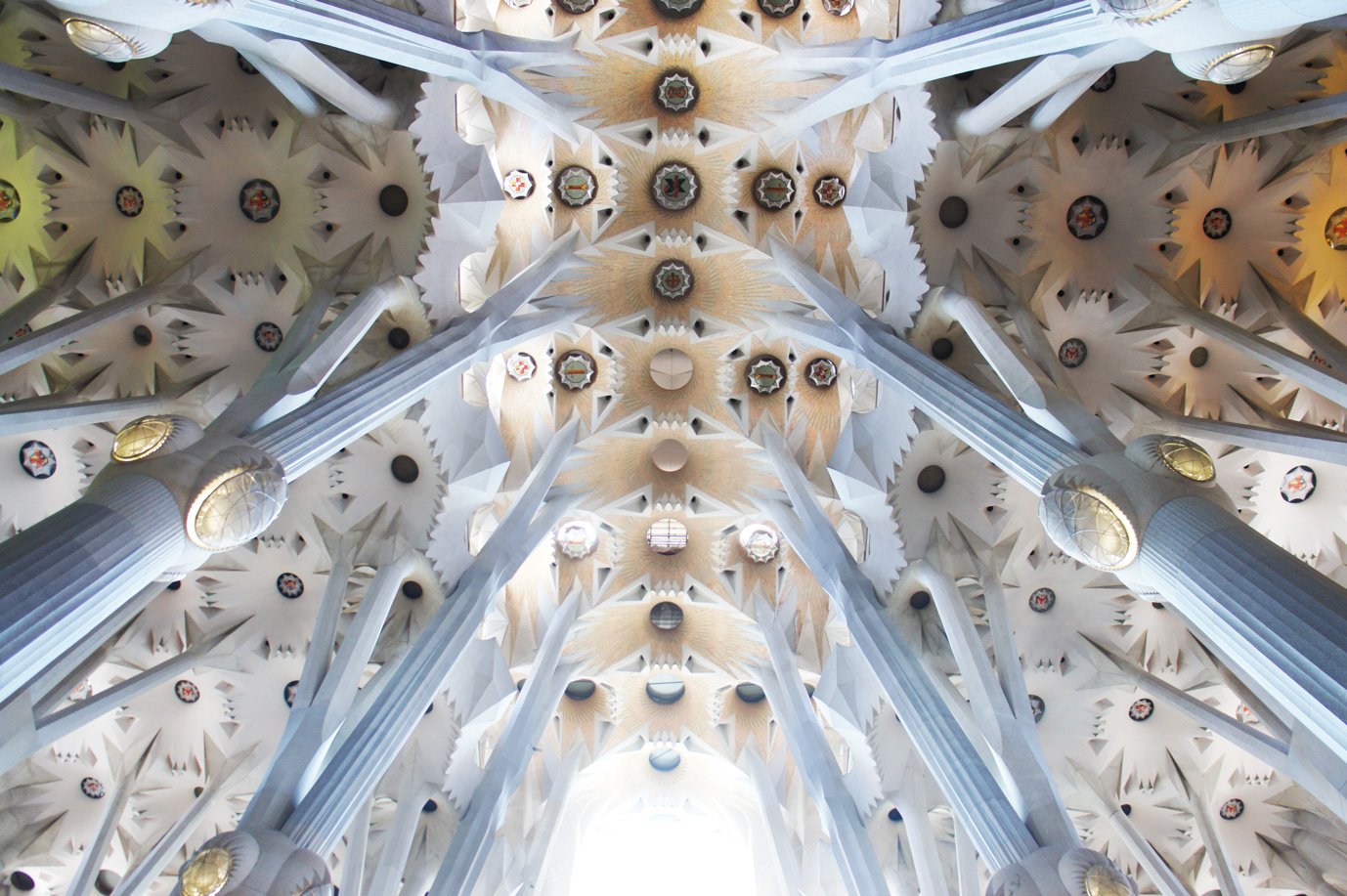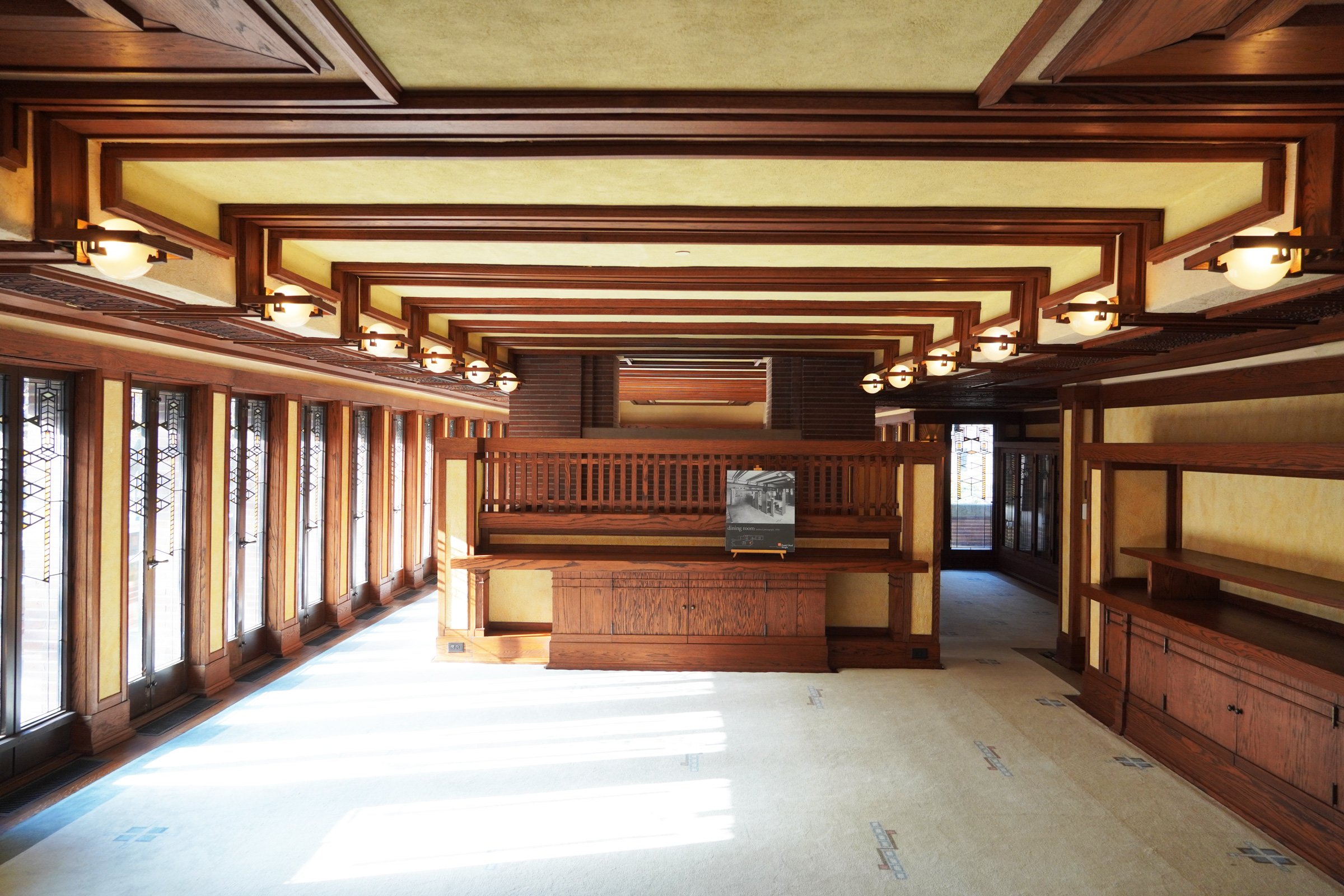The Story of Sagrada Familia and Architect Antoni Gaudi
Photograph of Sagrada Familia in Barcelona Spain by Architect Antoni Gaudi. Photograph Copyright by Mitchell Rocheleau
The first time I entered Sagrada Familia, I was mesmerized. I had never seen anything like it. The lightness, color, scale, and space were overwhelming. It wasn’t Gothic, Romanesque, or Classical. The inside was otherworldly, unidentifiable, and looked more like a forest than any recognizable architectural style.
The ambiance and atmosphere were captivating. The density of columns, detail, colors, light, and vaults reminded me of looking through a kaleidoscope as a child. In contrast to many other Cathedrals, the interior was light-hearted, optimistic, and bright. It transcended the seriousness and looming intimidation of other churches. It was accessible and fresh.
Sagrada Familia - A Seminal work of architecture
The Sagrada Familia tells the story of a larger cultural shift through its architecture. It illustrates a departure from the architectural styles of the past. Near the time that Gaudi was working on the Cathedral, new philosophies in architecture were beginning to develop. They questioned the slavish adherence to the historical forms and styles. Initially, the Cathedral was planned to be neo-gothic. Whether through cultural osmosis or an act of bold genius, Gaudi changed the trajectory of the design. Although there are still influences from the Gothic era in Cathedral, it is evident that there was an aesthetic departure that transcended the typical Gothic style. It was a courageous decision that would be the source of contention for many years.
Photograph of Sagrada Familia in Barcelona Spain by Architect Antoni Gaudi. Photograph Copyright by Mitchell Rocheleau
Antoni Gaudi - The Architect of Sagrada Familia
Gaudí was born on June 25th, 1852, in Reus, Catalonia, Spain. He studied architecture at a young age and quickly became interested in the Arts & Crafts Movement, which focused on handcrafted decorative arts rather than industrialized production processes. This passion led him to pursue a career as an architect, where he quickly developed a distinct style that blended European design with influences from nature and geometry.
In 1878 he qualified to be an architect. For several years he would accept small commissions around the city, including a factory, a series of lamp posts, a small shop, a flower stall, a gazebo, and various pieces of furniture. Although his notoriety was growing, his portfolio of work was limited.
Photograph of Sagrada Familia in Barcelona Spain by Architect Antoni Gaudi. Photograph Copyright by Mitchell Rocheleau
The Beginnings of Sagrada Familia
A bookseller named Josep Bocabella began selling a religious fundamentalist newspaper in the city. He made a significant amount of money and decided to build a church on the outskirts of Barcelona.
Bocabella hired architect Fransisco Villa to design the church that would later become known as Sagrada Familia. Villa’s preliminary plans were approved, and the first cornerstone was laid that year. Only a year later, there were disagreements between Villar and Bocabella. Villar resigned from his duties, and Bocabella needed a new architect to continue the work.
There are many different stories about how Gaudi was appointed, many of which suggest religious epiphanies, dreams, and signs from God. The legend says Bocabella saw a blue-eyed ginger man in his dream one night. The next day he saw this man in the studio of another architect and decided he was the one to design his church. This man was Antoni Gaudi.
Most likely, the selection was a much less romantic process. Gaudi’s reputation was growing, and his relationship with Mortorell, a mutual acquaintance between Gaudi and Bocabella, sparked the relationship between the two men. Ultimately, Antoni Gaudi was offered the position of chief architect to lead the work on the Cathedral.
The 31-year-old Gaudi accepted the commission and immediately set to work on his ambitious vision for the building. Seemingly overnight, Gaudi became one of the most well-known architects in Spain.
He would make radical changes to the design of the Cathedral. He proposed to increase the column heights to allow the crypt of the building to be a more noble scale. He quickly completed the crypt by 1889, allowing the church to host masses.
This strategy won the confidence of his clients and seemed to eliminate any doubts they may have had about his abilities. It bought time for Gaudi to contemplate a completely new design for the cathedral.
Photograph of Sagrada Familia in Barcelona Spain by Architect Antoni Gaudi. Photograph Copyright by Mitchell Rocheleau
construction of Sagrada Familia
Gaudi devoted nearly all his waking hours to Sagrada Familia and his religious practices. He was a profoundly spiritual man. He knew his grand vision for the cathedral would not be completed within his lifetime. For this reason, Gaudi chose to focus on one area of the building called the Nativity Façade. It is the most highly decorated and ornate façade of the building.
Gaudi would attempt to retell stories of the Bible in solid stone. The level of detail and extravagance achieved is astonishing. Focusing on one section of the building allowed the public to see his talents, encourage private donations, and provide a road map for his successors after he was gone.
Photograph of Sagrada Familia in Barcelona Spain by Architect Antoni Gaudi. Photograph Copyright by Mitchell Rocheleau
The Architecture of Sagrada Familia
The plan of the cathedral is a Latin cross with five aisles spanning down the nave. Gaudi designed eighteen spire-like towers representing the Twelve Apostles, four Evangelists, Mary, and Jesus. The two most prominent are the Mary and Jesus towers, which measure 170 meters tall. It is encircled by eight smaller spires that allude to angels on guard duty and symbolize eternity.
Inside the church is an equally remarkable interior decorated with stained glass windows, intricate mosaics, and walls filled with vibrant colors - all masterfully crafted by generations of artisans, architects, and engineers. The ceiling contains massive vaults which help support the structure while providing a sense of grandeur throughout the building. Visitors can also explore hidden chapels within the labyrinth-like passageways or admire various sculptures around its walls, each telling its own story related to the Catholic faith.
Photograph of Sagrada Familia in Barcelona Spain by Architect Antoni Gaudi. Photograph Copyright by Mitchell Rocheleau
The Catenary Curve
Gaudi not only took aesthetic inspiration from nature, but he also used it to derive the core engineering principles in the cathedral. One of the engineering forms often used was the catenary curve. This form can be seen everywhere in nature.
If a string is suspended from two points, it will hang in the shape of a catenary curve. When turned upside down, this shape creates an incredibly strong arched form. Gaudi performed many studies where he hung chain and weights from the ceiling to generate swaths of catenary curves. These studies allowed him to generate forms for the cathedral and understand the engineering forces generated. He would use a mirror or photographs to turn the image upside down and study the shapes they created. Historians have said that Gaudi’s understanding of architecture and engineering was nearly a century ahead of his time.
Photograph of Sagrada Familia in Barcelona Spain by Architect Antoni Gaudi. Photograph Copyright by Mitchell Rocheleau
Gaudi - The End of a Legacy
For the last decade of his life, he devoted nearly all his time to the Cathedral. He even began sleeping in his studio towards the end of his life. He also terminated many of his jobs so he could focus his efforts. Slowly his health and hygiene began to suffer as he became increasingly obsessed with the project.
Gaudi would work on Sagrada Familia for forty-three years. In 1926 while crossing the street, he was hit by a tram and passed away at 73. The tram driver mistook him for a beggar because of his disheveled appearance and tattered clothing. He was buried in the crypt at La Sagrada Familia.
During the last decade of his life, Gaudi made miniature scale models of the cathedral for his team to reference after he was gone. Unfortunately, these models would be destroyed in the Spanish Civil War. Fragments of these models were recovered, and the new team was tasked with reverse engineering Gaudi’s original design intent.
After Gaudi’s death, Domenec Sugranes I Gras became the lead architect. Between 1940 and 2012, he would be followed by Francesc Quintana, Isidre Puig Boada, Lluís Bonet I Gari, and Francesc Cardoner. The current architect on the project is Jordi Fauli I Oller.
Decades after Gaudi’s death, the new team began using advanced computer software to model the cathedral based on the recovered models and drawings. They began working with software used in the aerospace industry that could handle the complex curvatures Gaudi designed. Many of these software programs are still used today in the architectural industry.
Photograph of Sagrada Familia in Barcelona Spain by Architect Antoni Gaudi. Photograph Copyright by Mitchell Rocheleau
Gaudi’s Influence
Antoni Gaudi remains one of Catalonia's most renowned architects thanks to his pioneering creative style that incorporated natural elements into his buildings and urban development projects throughout Barcelona and beyond — proving himself to be ahead of the curve during an era dominated by traditional approaches to architecture. His influence continues even to this day.
Antoni Gaudí's influence on modern architecture has been immense; his Sagrada Familia has become an architectural icon and symbolizes human creativity and innovation. With construction still ongoing 130 years after its conception, it is a testament to Gaudi’s vision, genius, and passion.
Photograph of Sagrada Familia in Barcelona Spain by Architect Antoni Gaudi. Photograph Copyright by Mitchell Rocheleau
The Sagrada Familia Today
As part of their plan to finally finish what Gaudí started in 1882, specialists have been hard at work trying to reproduce and improve upon Gaudí's original architectural blueprints with modern materials while being mindful not to compromise any aspects of its identity or essence.
Today more than ever, progress can be seen taking place much faster, thanks primarily to donations from individuals who believe this vision should be realized sooner rather than later.
The monumental church remains one of human history's most famous and ambitious building projects. Despite the numerous delays and obstacles faced, it is estimated that the Sagrada Familia will be completed by 2026.
Photograph of Sagrada Familia in Barcelona Spain by Architect Antoni Gaudi. Photograph Copyright by Mitchell Rocheleau
References:
Hensbergen, Gijs Van, and Cornet Antonio Gaudí Y. The Sagrada Familia: Gaudi's Heaven on Earth. Bloomsbury Publishing, 2018.
AD Classics: La Sagrada Familia / Antoni Gaudí" 16 Oct 2013. ArchDaily. Accessed 20 Feb 2023. <https://www.archdaily.com/438992/ad-classics-la-sagrada-familia-antoni-gaudi> ISSN 0719-8884
Photograph of Sagrada Familia in Barcelona Spain by Architect Antoni Gaudi. Photograph Copyright by Mitchell Rocheleau
Photograph of Sagrada Familia in Barcelona Spain by Architect Antoni Gaudi. Photograph Copyright by Mitchell Rocheleau
Photograph of Sagrada Familia in Barcelona Spain by Architect Antoni Gaudi. Photograph Copyright by Mitchell Rocheleau











































Principal and Architect of ROST Architects, Mitchell Rocheleau, discusses the significance of The Grand Louvre designed by Architect I.M. Pei, the history of the Louvre, design process, design theory and ideas behind the project.